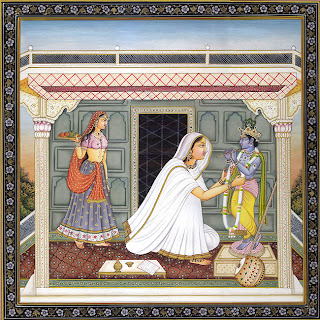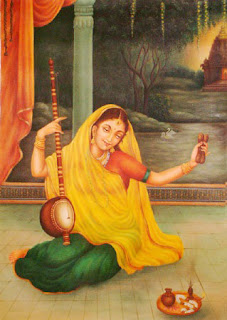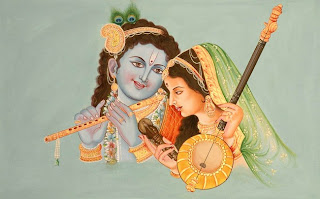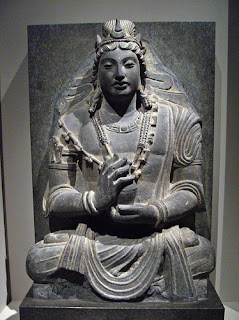Just as
the teaching of Buddhism is a development of Upanisadic philosophy, so the
mythology which grew up about Buddhism drew upon the traditions of the land in
which the doctrine was first taught. It sought both to prove the historic Buddha's
divine origin and to set him in the pattern of previous incarnations familiar to
Indian believers and interesting enough to compete with the existing pantheon.
As we have seen, Buddhism in turn provoked in early Hinduism a clarification of
doctrine and elements of the mythology.
Buddha's Previous Lives
Many
stories of Buddha's previous lives are related in the collection of stories
called the Jatakas, which show how he gradually acquired greater strength and
moral stature as his soul passed from one incarnation to the other.
We first
see him as the young Brahmin Megha, who while visiting the city of Dipavati
spoke to a young girl carrying seven lotus flowers. He asked her what they were
for and she replied that she wished to honour with them Lord Dipankara; that
she had bought five of them for five hundred coins and was given the other two
by a friend. Megha was interested in her description of Dipankara for he too
wished to attain enlightenment, and offered her five hundred coins for the five
lotus blooms. She accepted them only on condition that he would marry her.
After seeing the glory of Dipankara, the Buddha of the age before ours, and
hearing his sermons, Megha was strengthened in his resolve one day himself to
become a Bodhisattva. His calling had been predicted by Lord Dipankara.
In one
of Bodhisattva's lives he was a wise and holy hare. One day, while fasting, the
hare thought to himself that if anyone were to come begging he would have no
food to give him, and so he decided that should a beg-gar come he would give
him his own flesh to eat. As the hare was meditating thus, Sakra's throne grew
hot, and Sakra (Indra), curious to know what momentous spiritual event was
taking place on earth, discovered the hare and decided to test his resolve.
Accordingly Sakra took the form of a beggar and visited the hare, who without
hesitation invited the beggar to make a fire and then, having shaken free the
vermin in his coat so as not to harm them, threw himself into the fire. But
Sakra now froze the flames and told the hare that he had only been testing him.
In
order to commemorate his self-sacrifice, the god squeezed a mountain and, drawing
forth its juice, painted an image of a hare on the moon. In another life
Bodhisattva was Chadanta, a white elephant with six tusks who had two wives.
One of the wives, who was jealous of the other, prayed to be reborn as a human
princess.
When she was grown up she was married to the King of Benares, and
asked him to call together all the huntsmen of his kingdom. When he had done so
she instructed them to hunt down an elephant with six tusks and bring her back
the tusks. One of the huntsmen, Sonuttara, captured Chadanta in a pit and
wounded him with arrows. Chadanta asked the huntsman why he wanted to kill him
and was told about the Queen of Ben-arcs. Now he understood the meaning of his
fate and submitted to it.
He helped Sonuttara to climb up to the root of his
tusks, hut the huntsman found that they were too hard to cut. So Chadanta took
the saw in his trunk and himself cut off the tusks. He then collapsed in a pool
of his own blood and died. On hearing the story the queen also died.
 Bodhisattva
in one of his many in-carnations as a priest was a member of the household of
King Yasapani of &flares. He aroused the enmity of the corrupt Kalaka, for
he had given a fair judgment on a case where Kalaka had given unfair judgment.
Kalaka aroused the fears of the king at Bodhisattva's popularity, and suggested
that he should ask him to do some-thing impossible -and then put him to death
for not doing it. Yasapani therefore asked Bodhisattva to construct a pleasure
garden in a single day.
Bodhisattva
in one of his many in-carnations as a priest was a member of the household of
King Yasapani of &flares. He aroused the enmity of the corrupt Kalaka, for
he had given a fair judgment on a case where Kalaka had given unfair judgment.
Kalaka aroused the fears of the king at Bodhisattva's popularity, and suggested
that he should ask him to do some-thing impossible -and then put him to death
for not doing it. Yasapani therefore asked Bodhisattva to construct a pleasure
garden in a single day.
That
night as Bodhisattva lay awake wondering what to do, Sakra appeared before him
and assured him that the garden would be ready by the morning. Next day Sakra's
promise was seen to be fulfilled, and so it was with the subsequent tests which
the alarmed Yasapani set. Sakra created in turn a lake containing the seven
precious stones, a palace to go with the lake, and a jewel to match the splendour
of the palace. Finally Yasapani was convinced' of Bodhisattva's divine support
and adopted him as his friend. Kalaka was put to death.
In
another life Bodhisattva was the son of a rich king, Maharatha, and was called
Mahasattva. One day he and his two brothers were walking in the forest and came
across a tigress with her cubs. The tigress was emaciated and too weak to stand
up. At last Mahasattva began to reflect on the futility of physical existence
and determined to sacrifice his own life so as to feed the tigress. He lay down
before her, declaring that he wished to obtain release and enlightenment for
the benefit of the world. But the tigress was too weak to kill him; so
Mahasattva slit his throat, and the tigress, seeing the blood, began to eat.
Similarly,
in one of his lives as an ascetic, he sacrificed his own life, this time in
order to preach the virtue of patience. One day a king who had been an enemy of
Bodhisattva in previous lives came to disport himself with his wives in the
forest where the hermit lived. His wives, bored when the king fell asleep,
wandered into Bodhisattva's hermitage, where many came to hear his words,
including the gods. They too were entranced with his teaching, and hardly heard
the king when he entered the hermitage looking for them. The king began to
storm against them and the hermit, but Bodhisattva advised him to be patient.
The king retorted that he would teach the hermit to practise what he preached,
and drew his sword. Bodhisattva was cut to pieces, enduring his pain without
complaint.
Buddha's Birth
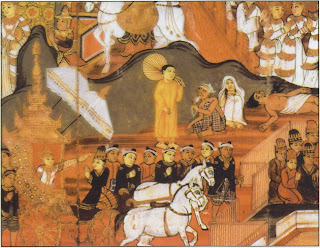 Mahamaya,
the wife of King Suddho-dana of Kapilavastu, dreamt one night of a white elephant entering her womb. She became pregnant and her womb became transparent
like a crystal casket. She felt an urge to with-draw for meditation to the
forest and there, while beneath a Sal tree, she gave birth from her side. The
child was born in full awareness and looking like the young sun; he leapt on to
the ground, and where he touched it there sprang up a lotus. He looked to the
four cardinal points, to the four half points, above and below, and saw deities
and mortals acknowledging his superiority. He made seven steps northwards, a
lotus appearing at each footfall. His birth was greeted by Asita, a sage from
the Himalayas, who likened him to Skanda, son of Agni. Astrologers made the
prediction that either he would be a great emperor or he would renounce life
and become a Buddha. He was named Siddhartha at a great ceremony at-tended by
eighty thousand relatives and one hundred and eight Brahmins, and was given a
hundred godmothers. Mahamaya, filled with joy, died two days after his birth.
Her sister Praia-pati, another of Suddhodana's wives, took charge of the
infant.
Mahamaya,
the wife of King Suddho-dana of Kapilavastu, dreamt one night of a white elephant entering her womb. She became pregnant and her womb became transparent
like a crystal casket. She felt an urge to with-draw for meditation to the
forest and there, while beneath a Sal tree, she gave birth from her side. The
child was born in full awareness and looking like the young sun; he leapt on to
the ground, and where he touched it there sprang up a lotus. He looked to the
four cardinal points, to the four half points, above and below, and saw deities
and mortals acknowledging his superiority. He made seven steps northwards, a
lotus appearing at each footfall. His birth was greeted by Asita, a sage from
the Himalayas, who likened him to Skanda, son of Agni. Astrologers made the
prediction that either he would be a great emperor or he would renounce life
and become a Buddha. He was named Siddhartha at a great ceremony at-tended by
eighty thousand relatives and one hundred and eight Brahmins, and was given a
hundred godmothers. Mahamaya, filled with joy, died two days after his birth.
Her sister Praia-pati, another of Suddhodana's wives, took charge of the
infant.
Boyhood
Siddhartha
was carefully educated for what his father hoped would be his destiny as a
great king. He was a proficient pupil, but not interested in military
exercises. His childhood companions were his cousin Devadatta and his
half-brother Ananda. Ananda became his great friend but Devadatta was a rival,
for the two boys were of opposed natures. Devadatta never forgave Siddhartha
for once nursing back to health a bird which he had shot for pleasure nor for
gaining the approval of the Elders for his action.
All
through his childhood, Suddho-dana took care to protect his son from exposure
to the outside world for, remembering the astrologers' prediction at the
child's birth, he wished above all to prevent him from renouncing life. He
built him three palaces, barring them to the outside world and its cares.
Marriage
When
Siddhartha came of age the bride chosen for him was Yasodhara, daughter of
Dandapani. But Dandapani insisted that he show military competence before he
would grant his daughter's hand, and so Siddhartha had to compete in a
tournament against Devadatta and Sundarnand. But the first event of the day was
no part of the formal tournament. Devadatta, on his arrival in the arena, killed
a white elephant. The next arrival was Sundarnand who, discovering who had
killed the elephant, threw it outside the city gate. Siddhartha than arrived,
lifted the elephant with his toe and threw it two miles, over seven walls and
seven moats. The tournament, composed of physical and intellectual tests, now
began. Siddhartha won in the horse race, the chariot race, in music, recitation,
mathematics and elocution. He and Devadatta tied in archery, then in wrestling;
at last, in the fencing test, Devadatta won. He expected to be declared winner
of the tournament on the basis of this, and so was doubly chagrined when
Yasodhara passed him over and gave the garland to Siddhartha, for Yasodhara was
his wife in previous lives and had promised to be his wife in all.
 According
to another version, five hundred princesses were assembled so that Siddhartha
could make a choice of bride. His father gave him jewels to distribute among
them according to his preferences. Siddhartha gave each one a jewel, and just
as he had given out the last one, Yasodhara arrived. Having no more jewels, Siddhartha
gave her his signet ring, and this was a sign of their betrothal.
According
to another version, five hundred princesses were assembled so that Siddhartha
could make a choice of bride. His father gave him jewels to distribute among
them according to his preferences. Siddhartha gave each one a jewel, and just
as he had given out the last one, Yasodhara arrived. Having no more jewels, Siddhartha
gave her his signet ring, and this was a sign of their betrothal.
Siddhartha
and his young bride led an idyllic life, despite the fact that Suddhodana,
becoming more fearful as the years went past that somehow his son would get to
know of sickness and death, had confined him to the upper floors of the palace.
Suddho-dana made sure that they were ever filled with charming and voluptuous
women so that Siddhartha could fully indulge all the pleasures of the senses. The
Bodhisattva thus led a life of thoughtless pleasure and never dreamt of the
outside world, for a necessary preliminary to enlightenment is full knowledge
of the senses.
The Four Signs
Before
long, however, the devas decided that it was time for the Bodhisattva to begin
his life's work, and so they filled the universe with the thought that it was
time to go forth. Siddhartha became conscious of a wish to leave the palace and
to see the city and persuaded his father to allow him to go forth accompanied
by a charioteer, Chandaka. Suddho-dana took elaborate precautions: he had the
streets cleaned and decorated and issued orders that no old or sick men should
be allowed near the route to be followed. But the devas had other plans. On
Siddhartha's first outing one of them took the form of a feeble broken-down old
man and stood by the wayside. Siddhartha was astonished when he saw this
figure, for no one had even spoken to him of old age, and he was more surprised
when Chandaka, at his insistence, explained that all people were subject to
aging.
Siddhartha took three more chariot rides into the city, and on each
occasion one of the gods stood by the route to teach him the true nature of
life lessons to which his previous ignorance made him especially receptive.
Thus he saw in turn a helpless sick man, a dead man being carried on a bier,
and a monk, calm and self-controlled. The prince came to learn that all that is
born must die; that sickness comes to all; that he himself would one day die;
and that renunciation was the path to peace of mind and honour and to salvation
both for the man who withdraws from the world and for others. These revelations
confirmed Siddhartha in his half-felt instincts, and he formed the idea that he
too would withdraw from the grief of the world. Soon after this, Yasodhara gave
birth to a son, Rahula. Each Buddha has to have a son before renouncing the
world, and so the birth of Rahula was a sign to Siddhartha that the moment had
come for departure. He in-formed his father of his intention, but Suddhodana
was horrified and locked him up in the palace. He lavished everything on his
son, increasing the comfort and gaiety of his life.
 But this did nothing to
weaken Siddhartha's resolution. On the night that he decided to make his escape
there was revelry in the palace; the devas caused all the company to drink too
much, and then to fall asleep suddenly in the midst of their pleasures.
Siddhartha alone was awake. He saw with disgust the mass of men and women,
lying in immodest postures, their mouths hanging open and their clothes in
disarray. He went to the apartments of Yasodhara, and looked for a while on his
sleeping wife and son. Then he departed.
But this did nothing to
weaken Siddhartha's resolution. On the night that he decided to make his escape
there was revelry in the palace; the devas caused all the company to drink too
much, and then to fall asleep suddenly in the midst of their pleasures.
Siddhartha alone was awake. He saw with disgust the mass of men and women,
lying in immodest postures, their mouths hanging open and their clothes in
disarray. He went to the apartments of Yasodhara, and looked for a while on his
sleeping wife and son. Then he departed.
The Search for Enlightenment
The
devas aided Siddhartha in his firm resolve. As he approached the heavy gates of
the palace their locks swung open; the devas lulled the guards to sleep, and
they softened the footfalls of Siddhartha's horse, Kan-taka. So he escaped from
his father's vigilance, accompanied only by Chandaka. Shortly they reached the
River Anoma ('illustrious'), and here Siddhartha instructed Chandaka to return
to the palace. He divested him-self of all his jewels, the symbols of his
princely estate, cut off his long black hair, and gave them to the faithful
charioteer, telling him to take back to Kapilavastu the message that either
Siddhartha would extinguish old age and death and would return soon to
Kapilavastu, or, lacking the strength, he would go to perdition and never be
seen again. Chandaka, tears in his eyes, kissed his master's feet and then
Kantaka licked them. Then, leading the horse, the charioteer returned
unwillingly to the cap-ital. But before he had gone many paces the faithful
horse died. When he returned with Siddhartha's message there was great
lamentation in Kapilavastu; but Yasodhara, faithful to her husband, cut off her
hair and became a nun.
As
Siddhartha continued on his journey in search of truth the devas once more
intervened. One appeared before him as a hunter, and ex-changed clothes with
him; the other appeared as a barber and shaved his head, so that Siddhartha now
looked like a simple monk. After a few days he joined the three hundred pupils
of Arara Kalama, a great sage, at Vaisali. He completed his studies with Kalama
but still was not satisfied. He then attended the philosophy classes of
Rudraka, but this was no better, and Siddhartha decided that know-ledge cannot
bring enlightenment. He and five other students left Rudraka and began to
practise austerities. They continued, under Siddhartha's leadership, for some
time and with such ardour that they were all reduced practically to skeletons.
But once more Siddhartha was disappointed, and decided that asceticism was no
more the path to enlightenment than knowledge, for it so weak-ens the body that
the physical shell encumbers the spirit. Siddhartha abandoned his five
disciples, much to their scorn, and went to bathe in a river. There, in his
weakness, he nearly drowned, but was saved by a deva living in a tree, who
stretched out his jewelled arm to save him.
 Then Siddhartha sought his first
meal. The dish from which he ate was seized by a Naga and taken to the nether
regions, but was afterwards snatched tip to heaven by Sakra (Indra), taking the
form of Garuda.
Then Siddhartha sought his first
meal. The dish from which he ate was seized by a Naga and taken to the nether
regions, but was afterwards snatched tip to heaven by Sakra (Indra), taking the
form of Garuda.
Siddhartha
then spent seven fruitless years in search of enlightenment. Almost daily
Suddhodana sent messengers to him imploring him to re-turn, but Siddhartha
steadfastly refused to come home until he had found enlightenment.
Enlightenment
Despite
his refusals to go back to his home Siddhartha began to wonder whether after
all enlightenment was attainable, or whether he had under-gone seven years of
privation for nothing. He was 35 years old. At length he passed through the
country of Magadha, and decided that he would stake all in a last attempt. Near
the town of Uruvela he seated himself in a lotus posture beneath a pipal tree
born on the same day as himself, determined not to rise until he had achieved
enlightenment.
As he
settled himself for the great spiritual discovery the gods rejoiced in heaven
and birds soared overhead in joyful anticipation. But the evil spirits were
troubled, and their chief, Mara, attempted to distract him. First he informed
him that his rival Devadatta had usurped the throne; but Siddhartha was
unmoved. Then he raised a great storm which assailed the Bodhisattva with
showers of rain, javelins, swords, arrows, rocks, hillocks and burning
charcoal; but Siddhartha took no notice. Lastly he sent his three daughters,
Discontent, De-light and Thirst, to seduce him; but the Bodhisattva addressed
them and they were converted by his words. These temptations continued
throughout the night, but Siddhartha resisted them all.
After
four times seven days of fasting and deep meditation he obtained enlightenment,
and became the Buddha. As he rose from his seat under the Bodhi tree (the tree
of enlightenment), he declared that Mara was overcome, that all evil was
destroyed and that he, Buddha, was the lord of the three worlds.
Preaching
Buddha
now had to make the choice between preaching the truth to all the world and
seeking only his own salvation. Brahma appeared before him and asked him to do
the former; Mara, having failed to prevent Buddha's own enlightenment, now
urged the latter course. But Buddha decided to remain and teach. Two merchants,
with whom he had his first meal after enlightenment, became his first disciples.
Then Buddha decided to seek out his old teachers. Trying to cross the Ganges,
he had no money to pay the ferryman, who refused to take him over for the price
of 'rowing him across the ocean of life'. So Buddha took flight and soared over
the river.
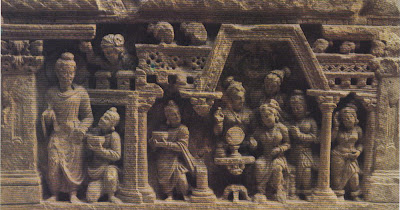 He
found his teachers dead, but his five disciples still deep in their asceticism
in the Deer Park at Sarnath near Benares. As they saw him approaching they
resolved not to rise and greet him, because he had abandoned his vows; but
despite them-selves they got up and showed him reverence. But they did not yet
call him Buddha, and laughed when he explained to them that they should show
him the proper respect. Nevertheless he had the patience to teach them the Four
Holy Truths and the Holy Eightfold Path, the product of his enlightenment.
Though the teaching of the Law (Dharma) came to Buddha by sudden revelation, we
can see how it is the product of the experience of all his lives as a Bodhisattva.
The Four Holy Truths are that birth, age, sickness and death are sorrow, and so
is the clinging to earthly things; that the chain of reincarnation is. the
direct result of attachment to life and of desire; that the extinction of desire
is essential for the attainment of detachment; and that the only way to
extinguish desire is to follow the Eightfold Path. The Path consists of right
belief (freedom from illusion, maya); right intention; right word truth and
openness; right conduct, peaceful and pure; right living, causing no injury;
right effort to-wards self-control; right thinking applying the mind to
religious experience; and right meditation on all the mysteries of life.
He
found his teachers dead, but his five disciples still deep in their asceticism
in the Deer Park at Sarnath near Benares. As they saw him approaching they
resolved not to rise and greet him, because he had abandoned his vows; but
despite them-selves they got up and showed him reverence. But they did not yet
call him Buddha, and laughed when he explained to them that they should show
him the proper respect. Nevertheless he had the patience to teach them the Four
Holy Truths and the Holy Eightfold Path, the product of his enlightenment.
Though the teaching of the Law (Dharma) came to Buddha by sudden revelation, we
can see how it is the product of the experience of all his lives as a Bodhisattva.
The Four Holy Truths are that birth, age, sickness and death are sorrow, and so
is the clinging to earthly things; that the chain of reincarnation is. the
direct result of attachment to life and of desire; that the extinction of desire
is essential for the attainment of detachment; and that the only way to
extinguish desire is to follow the Eightfold Path. The Path consists of right
belief (freedom from illusion, maya); right intention; right word truth and
openness; right conduct, peaceful and pure; right living, causing no injury;
right effort to-wards self-control; right thinking applying the mind to
religious experience; and right meditation on all the mysteries of life.
Buddha's
exposition of the Dharma in the Deer Park is referred to as the first turning
of the Wheel of the Law. The Buddha revealed by this doctrine is clearly very
different from that portrayed as the ninth avatar of Vishnu, for his teaching
is that neither asceticism nor indulgence is the path to enlightenment. But
this part of Buddha's life hardly belongs to mythology; it is, however, the
core round which the specifically Buddhist mythology was constructed.
'
Buddha's
five disciples were joy-fully converted, and after them many others. Buddha
exhibited his miraculous powers as an aid to conversion. Among his converts
were five hundred robbers, reclaimed in a mass conversion, who all became mendicants;
thousands of people at Sravasti, who watched him walking on air and emitting
light from his body; others before whom he multiplied his body; and King
Bimbisara and his retinue of 'twelve myriads of men'.
At
last, at the invitation of his son Rahula, Buddha went back as promised to his
home at Kapilavastu. At first his return seemed hardly the triumph that
Suddhodana had expected. Before seeing his family Buddha went begging for food
in the streets of Kapilavastu; his father was horrified that his son should
thus bring disgrace on his family. Buddha explained that he was no longer of
the race of kings, but of the race of those who beg for their food; and that a
man's station in life should depend on him and not upon his birth. He then
preached the Dharma to his father and converted him. Next he went to seek his
wife, who alone of the family had not greeted him. As soon as they were
reunited she fell down and worshipped him and, upon her conversion, resolved
together with Siddhartha's foster-mother Prajapati to found an order of nuns.
Two
more important conversions were to follow. The first was of Ananda, to whom Buddha spoke on the eve of his wedding. The wedding, however, never took place;
for Buddha, giving him a begging bowl, convinced Ananda that the greatest
festival is the life of a monk who has attained Nirvana. Ananda, granted a
vision of heaven and goddesses, was now to become Buddha's most faithful
follower. The other conversion was of his own son Rahula, who came to his
father asking for his patrimony and through Buddha's teaching was given an
everlasting spiritual inheritance and became a monk. Fin-ally Buddha ascended
to the Heaven of the Thirty-three Divinities to convert his mother. He remained
there for three months and accepted alms from the gods, who gained spiritual
calm from his presence. On his return he was accompanied by Sakra (Indra) and
the other gods and by a host of Brahmins, and was greeted on earth by all its
kings, who bowed low to receive him.
The Opposition to Buddha
The great
success of Buddha's teaching created enemies for him and these were led by
Devadatta, his rival from childhood. Devadatta's hatred of Buddha had steadily
grown and now he sought to destroy him and his movement. His first tactic was
to engineer a schism among Buddha's followers. Having weakened the movement
from within, Devadatta removed one of its most powerful supporters, Ajasat, the
son of King Bimbisara, Buddha's patron. He made an alliance with the king, and
after gaining his confidence incited Ajasat to murder his own father. Next he
planned an attack on Buddha himself. Enlisting the help of thirty-one of
Ajasat's servants, he instructed one of them to murder Buddha. Then he arranged
that another two would murder the first; another four would murder these two, a
further eight would murder the previous four, and sixteen would murder the
eight. Then he intended to murder the sixteen.
But the
plan came to nothing, for as soon as Ajasat's servants heard Buddha preaching they
became firm converts. Devadatta made a second attempt on Buddha's life; he had
a great boulder rolled down a mountainside in the hope that it would crush
Buddha; but before it reached him it split in two and fell to either side. The
third plan was to set a drunken elephant, Malagiri, to crush Buddha as he was
begging for alms. The people all around were terrified and fled; only Ananda,
despite his fear, remained, admiring Buddha who advanced calmly, quite unmoved.
As the elephant came nearer, Buddha's spiritual power overcame its spirit; the
creature faltered, and finally came to Buddha and laid its head on the ground
before him. Following this incident all Devadatta's followers were converted
and he, in despair, fell ill. When he recovered from his illness it was generally
believed that he had repented. He went to visit Buddha in his monastery; but his
true motives were revealed as he approached the gate, for flames shot out of
the earth and consumed him.
The Desire for Death
Buddha's
ministry continued for forty-five years, and one day Mara, the Evil One
himself, approached him, again attempting to persuade him to accept Nirvana for
himself and to forget about helping others to attain it through his preaching.
To Mara's surprise, for Buddhas have the power to live to the end of the aeon,
Buddha replied that he would live for only three months more. As he spoke the earth
trembled and Indra's thunderbolts flashed. Ananda came to him and asked why the
universe was moved and filled with portents, and Buddha explained that he had
given up his desire to live. He then adopted a position of yogic concentration
and shook off the life remaining to him; thereafter his psychic power alone
sustained him in a state where he was free from the bonds of Becoming.
 When he
knew that death was near Buddha made his last journey, to Ku-sinagra in the
country of the MaIlas. He reached a grove of Sal trees which were flowering out
of season and there lay down for his last rest on earth. He was visited by
kings and noblemen and Brahmins, who had been summoned by Ananda from all the
neighbouring countries. He spoke kindly to all who came, turning none away, and
comforted Ananda and his other disciples, who despite some degree of holy
detachment could not re-strain their grief. Charging them to pursue their
salvation diligently, Buddha fell unconscious and shortly died.
When he
knew that death was near Buddha made his last journey, to Ku-sinagra in the
country of the MaIlas. He reached a grove of Sal trees which were flowering out
of season and there lay down for his last rest on earth. He was visited by
kings and noblemen and Brahmins, who had been summoned by Ananda from all the
neighbouring countries. He spoke kindly to all who came, turning none away, and
comforted Ananda and his other disciples, who despite some degree of holy
detachment could not re-strain their grief. Charging them to pursue their
salvation diligently, Buddha fell unconscious and shortly died.
As
Buddha's soul entered into Nirvana the earth trembled and was shrouded in
darkness, while the heavens were lit up with a strange light and crossed by
flashing thunderbolts. High winds swept over the earth and the rivers seemed to
boil.
The lesser spirits Nagas, yakshas and Gandharvas bowed in grief, but the
higher gods who understood the meaning of these portents rejoiced. The body lay
in state for six days and on the seventh was placed on a great funeral pile.
There was great difficulty in igniting the pyre, but when the moment had come,
divinely ordained, the fire lit of its own accord. When the fire had done its
work Buddha's remains were seen, looking like a heap of pearls. They were
divided into eight parts and taken reverently by eight princes into kingdoms
near and far.
Buddhist Cosmology and the Buddhist
Pantheon
Buddhism,
with its strictly philosophical nature, was to the ordinary mind a distant and
lofty creed. As time went by some of the age-old beliefs crept in and mingled
with the new. Popular Buddhism is a strange mixture of Mahayana and the Hindu
pantheon and cosmology.
The Buddhist
universe is called Chakravala and there are three planes: above, around and
below Mount Meru. The lower plane contains one hundred and thirty-six hells,
each reserved for a particular type of sinner. Revilers of Buddha and the Law
are sent to Avici, the lowest. Souls arc reborn into the world after a period
in one of these hells. These periods last at least five hundred hell years,
each day of which equals fifty years on earth. The plane around Mount Meru
contains the worlds of animals, ghosts (Pretas beings consumed with hunger and
thirst), demons and men.
Around the peak of Mount Meru is the Heaven of the
Four Great Kings: Dhritarashtra, guardian of the East; Virupaksha, guardian of
the South; Virupaksha, guardian of the West; and Kubera, or Vaisravana,
guardian of the North. Above this heaven is the Heaven of the Thirty three
Divinities or the Heaven of Sakra (Indra). Above these two heavens and the
summit of Meru are twenty four more heavens, one on top of the other, all lit
with their own radiance. Six are inhabited by those who enjoyed the pleasures
of the senses. The other heavens above are the Chyana Lokas (regions of
abstract meditation) and the Arupa Lokas (formless worlds), reserved for souls
of a high order such as Buddhas and Arhats.
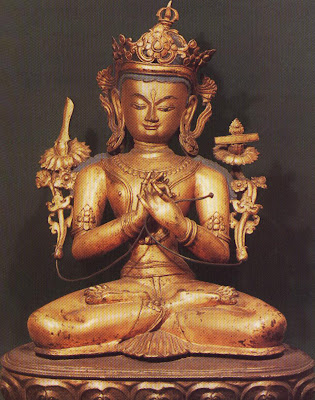 Much of
the Hindu pantheon has also been adapted to meet the needs of popular Buddhism,
though the gods' functions are generally quite different. Indra (Sakra) is
still king of the gods and Yama, called Dharma-raja, presides over the hells.
But Shiva and Parvati, usually called Mahakala and Mahakali, are reduced to
being Buddha's doorkeepers, while Kubera, called Jambhala, is his bodyguard.
The goddesses of the Buddhist pantheon are reminiscent of the Shiva/ Sakti
cults, though in their cruel aspects they often outdo Durga and Kali. The most
revered of these goddesses is Tara, who is yellow, red or blue when she
threatens and white or green when gentle and loving. Other terrifying goddesses
are Kurukulla, and Cunda who, according to the spirit of the onlooker, appears
to bear either arms or symbols of divine charity. Hariti, Kubera's wife,
suckles five hundred demons and her principal feature is her inexhaustible
fecundity. Ushas, the goddess of dawn, has her counterpart in Marishi but
unlike Ushas she is frightening; she has a third eye on her brow like Shiva,
three hideous faces and ten threatening arms. Gentler goddesses are Saraswati,
goddess of teaching, and the chief goddess, Prajna, goddess of knowledge.
Much of
the Hindu pantheon has also been adapted to meet the needs of popular Buddhism,
though the gods' functions are generally quite different. Indra (Sakra) is
still king of the gods and Yama, called Dharma-raja, presides over the hells.
But Shiva and Parvati, usually called Mahakala and Mahakali, are reduced to
being Buddha's doorkeepers, while Kubera, called Jambhala, is his bodyguard.
The goddesses of the Buddhist pantheon are reminiscent of the Shiva/ Sakti
cults, though in their cruel aspects they often outdo Durga and Kali. The most
revered of these goddesses is Tara, who is yellow, red or blue when she
threatens and white or green when gentle and loving. Other terrifying goddesses
are Kurukulla, and Cunda who, according to the spirit of the onlooker, appears
to bear either arms or symbols of divine charity. Hariti, Kubera's wife,
suckles five hundred demons and her principal feature is her inexhaustible
fecundity. Ushas, the goddess of dawn, has her counterpart in Marishi but
unlike Ushas she is frightening; she has a third eye on her brow like Shiva,
three hideous faces and ten threatening arms. Gentler goddesses are Saraswati,
goddess of teaching, and the chief goddess, Prajna, goddess of knowledge.
The
gods exceed Shiva in his terrifying aspect. One, Yamantaka, accompanies
Manjusri, the con-sort of Saraswati, and like Shiva wears a necklace of skulls,
has several heads and many arms. Another, Trailoky-vavijaya, has four heads and
four menacing arms and tramples Shiva underfoot.
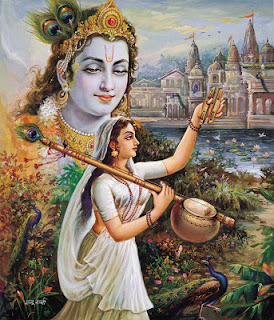 Look at
those eyes, those beautiful little orbs that seem to reflect the whole universe
and point to the Unknown. The gospel of Love and Truth that they are preaching,
the religion of tears that they are proclaiming, the joy of holiness that they
are showering, all shed a glow at once resplendent and captivating. Their
language is so mute, yet so expressive; they have no tongue, yet speak so
vividly of the mighty experiences of the days of separation and recite the tale
of pathos, of parting and of meeting, with a clarity that transcends the
attempts of the artist's brush. On canvas I have witnessed many sights, but
seldom has it been rendered so living as when I saw tears of gratitude in the
penitent's eye as he sat bathing under the showers of the Master's grace, or
the pearly drops in the eyes of the devotee as he sat in meditation. Few
realize, much less experience, the joys that fall to the lot of the Blessed.
These are the children of God, nurtured on the bed of sorrow, on whose head was
showered the ridicule of the world, whose food has been the crushings of their
heart and whose drink has been the pangs of affliction. Some born in the manger,
others discovered forlorn by the tank, and yet others forsaken to the fire and
the winds, these are the heralds that announce the approach of a higher power
that points to the great IDEAL. Their joy is in the distant meeting and their
satisfaction lies in the gleaming hope that sheds lustre in the distance and
whose prize is the CROWN OF ETERNAL BLISS. Such are the devotees of the Lord.
Look at
those eyes, those beautiful little orbs that seem to reflect the whole universe
and point to the Unknown. The gospel of Love and Truth that they are preaching,
the religion of tears that they are proclaiming, the joy of holiness that they
are showering, all shed a glow at once resplendent and captivating. Their
language is so mute, yet so expressive; they have no tongue, yet speak so
vividly of the mighty experiences of the days of separation and recite the tale
of pathos, of parting and of meeting, with a clarity that transcends the
attempts of the artist's brush. On canvas I have witnessed many sights, but
seldom has it been rendered so living as when I saw tears of gratitude in the
penitent's eye as he sat bathing under the showers of the Master's grace, or
the pearly drops in the eyes of the devotee as he sat in meditation. Few
realize, much less experience, the joys that fall to the lot of the Blessed.
These are the children of God, nurtured on the bed of sorrow, on whose head was
showered the ridicule of the world, whose food has been the crushings of their
heart and whose drink has been the pangs of affliction. Some born in the manger,
others discovered forlorn by the tank, and yet others forsaken to the fire and
the winds, these are the heralds that announce the approach of a higher power
that points to the great IDEAL. Their joy is in the distant meeting and their
satisfaction lies in the gleaming hope that sheds lustre in the distance and
whose prize is the CROWN OF ETERNAL BLISS. Such are the devotees of the Lord. 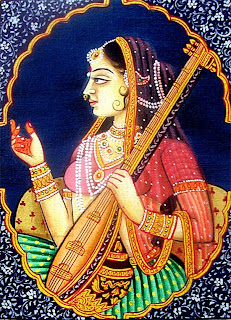 I lay
in the lap of my mother, hearing the tale of one such child of the Lord, when
the motherly caresses lulled me to sleep and lo! in my dreams whom else should
I meet but child of my fancy and I cried out...
I lay
in the lap of my mother, hearing the tale of one such child of the Lord, when
the motherly caresses lulled me to sleep and lo! in my dreams whom else should
I meet but child of my fancy and I cried out... 
